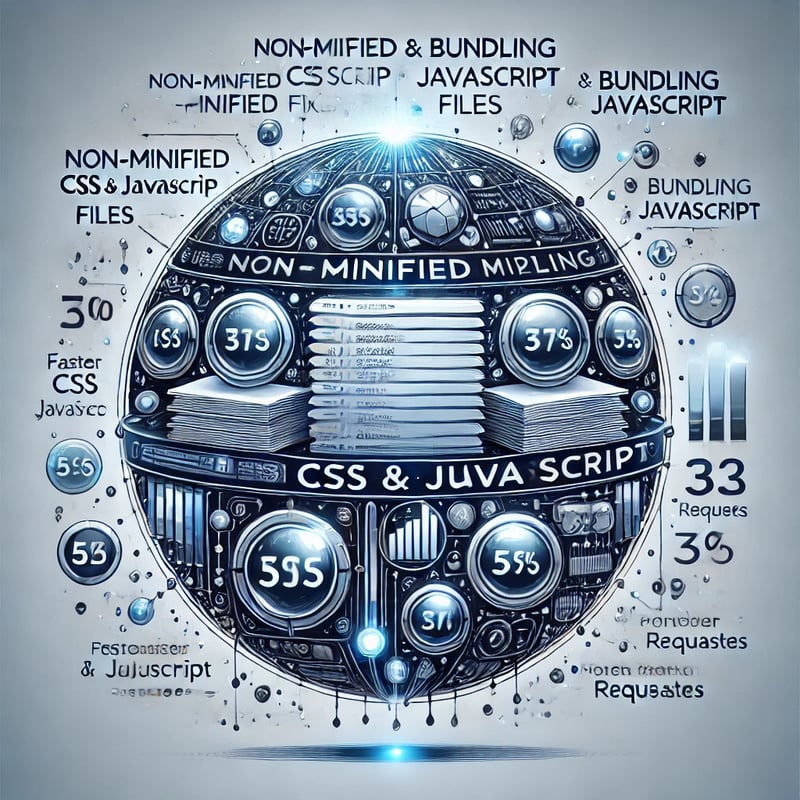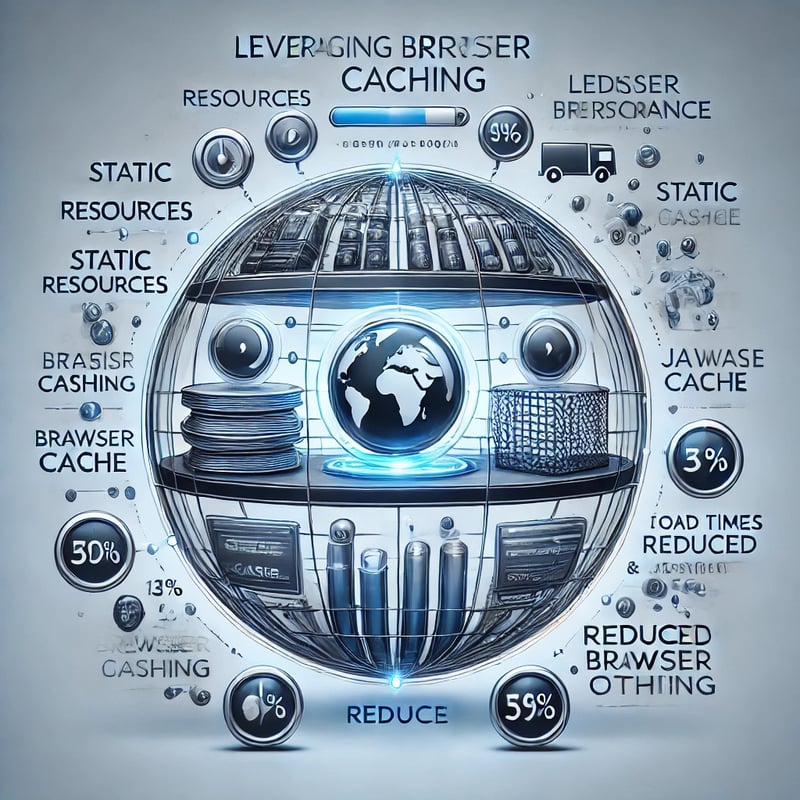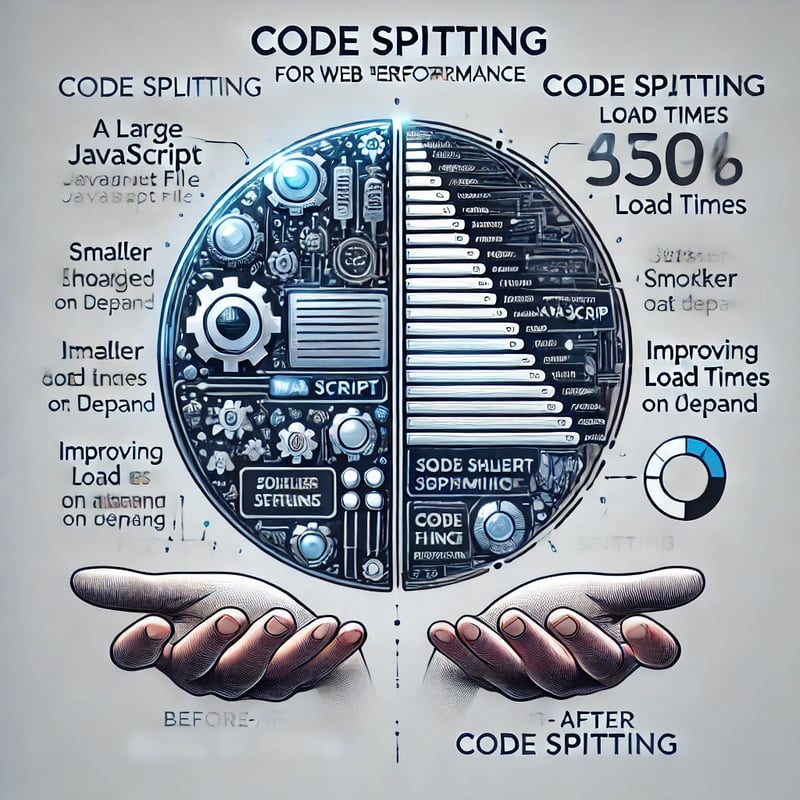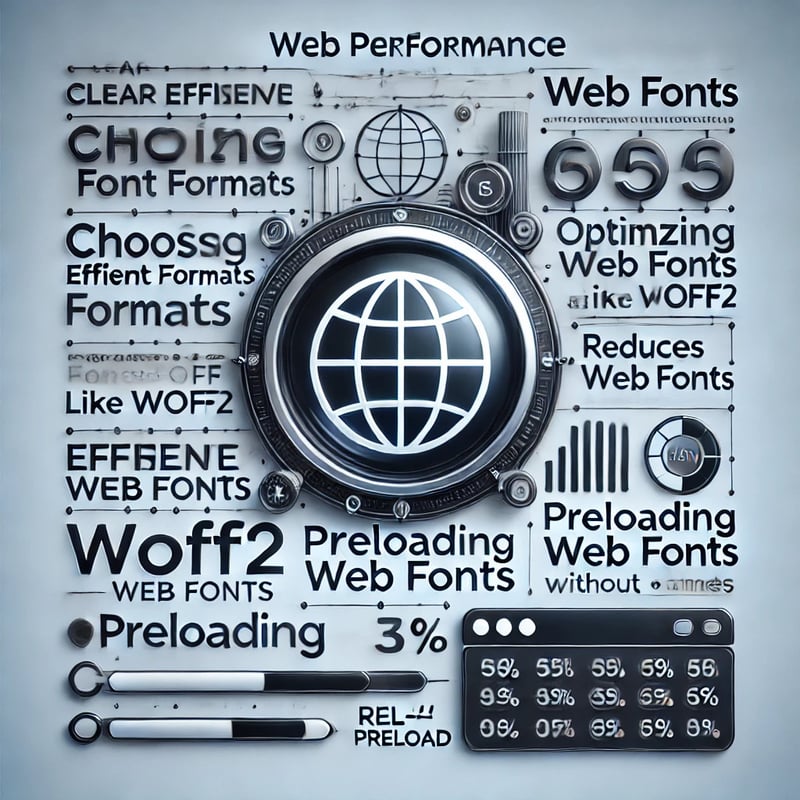Optimizing Web Performance: Best Practices and Techniques
Introduction
Caption: A comparison between a slow-loading website and a fast-loading website, highlighting the impact on user engagement.
In today's fast-paced digital landscape, web performance is a critical factor that directly impacts user experience, engagement, and conversion rates. A slow-loading website can lead to higher bounce rates, lower user satisfaction, and ultimately, lost revenue. On the other hand, a well-optimized website enhances user experience, improves search engine rankings, and drives higher engagement, resulting in better business outcomes.
Understanding Web Performance
Caption: Various web performance optimization techniques, including image compression, code minification, and browser caching, all contribute to a fast-loading, responsive website.
Web performance refers to how quickly and efficiently web pages are loaded, rendered, and become interactive in a user's browser. Multiple factors influence web performance, including server response times, resource loading, rendering processes, and network latency. Effective optimization requires a holistic approach addressing each factor to ensure a smooth and fast user experience.
Key Metrics for Web Performance
Before diving into optimization techniques, it's essential to understand the key metrics used to measure web performance. These metrics help you identify bottlenecks and assess the effectiveness of your optimizations:
First Contentful Paint (FCP): The time it takes for the first piece of content to appear on the screen, giving users a visual indication that the page is loading.
Time to Interactive (TTI): The time it takes for the page to become fully interactive, meaning the user can engage with it without delays.
Largest Contentful Paint (LCP): The time it takes for the largest visible element (such as a hero image or a large text block) to load.
Cumulative Layout Shift (CLS): Measures the amount of unexpected layout shifts during the page's lifespan.
Image Optimization

Caption: Various web performance optimization techniques, including image compression, code minification, and browser caching, all contribute to a fast-loading, responsive website.
Images are often the largest assets on a web page, making them a significant factor in load times. Optimizing images can drastically reduce page weight and improve load speed, leading to a faster and more efficient website.
Minifying and Bundling CSS and JavaScrip

Caption: Various web performance optimization techniques, including image compression, code minification, and browser caching, all contribute to a fast-loading, responsive website.
Minification is the process of removing unnecessary characters (such as whitespace, comments, and line breaks) from CSS and JavaScript files. This reduces file size, leading to faster downloads and improved performance. Bundling, on the other hand, involves combining multiple files into a single file to reduce the number of HTTP requests required to load a page.
Leveraging Browser Caching

Caption: Various web performance optimization techniques, including image compression, code minification, and browser caching, all contribute to a fast-loading, responsive website.
Browser caching allows static resources (like images, CSS, and JavaScript files) to be stored in the user's browser, reducing the need to download them again on subsequent visits. This can significantly decrease load times for returning users, improving the overall user experience.
Code Splitting

Caption: Various web performance optimization techniques, including image compression, code minification, and browser caching, all contribute to a fast-loading, responsive website.
Code splitting is the practice of breaking up your JavaScript code into smaller bundles that can be loaded on demand. This technique is particularly useful for large single-page applications (SPAs) where loading the entire JavaScript bundle upfront can delay the initial page load.
Optimizing Web Fonts

Caption: Various web performance optimization techniques, including image compression, code minification, and browser caching, all contribute to a fast-loading, responsive website.
Web fonts, while enhancing typography and branding, can significantly impact performance if not managed properly. Here are some best practices for optimizing web fonts:
Advanced Caching Strategies

Caption: Various web performance optimization techniques, including image compression, code minification, and browser caching, all contribute to a fast-loading, responsive website.
Beyond browser caching, advanced caching strategies can further enhance performance, especially for dynamic content and offline capabilities.
Conclusion
Caption: Various web performance optimization techniques, including image compression, code minification, and browser caching, contribute to a fast-loading, responsive website.
Optimizing web performance is a critical ongoing process that directly influences user experience, search engine rankings, and business outcomes. You can significantly improve your website's load times and overall performance by following the best practices outlined in this article, from image optimization and code minification to advanced caching strategies and code splitting.
Additional Resources
Google Lighthouse
WebPageTest
TinyPNG
Webpack Documentation
Service Worker API
-
 Can You Use CSS to Color Console Output in Chrome and Firefox?Displaying Colors in JavaScript ConsoleIs it possible to use Chrome's console to display colored text, such as red for errors, orange for warnings...Programming Posted on 2025-04-10
Can You Use CSS to Color Console Output in Chrome and Firefox?Displaying Colors in JavaScript ConsoleIs it possible to use Chrome's console to display colored text, such as red for errors, orange for warnings...Programming Posted on 2025-04-10 -
 How to Resolve \"Refused to Load Script...\" Errors Due to Android\'s Content Security Policy?Unveiling the Mystery: Content Security Policy Directive ErrorsEncountering the enigmatic error "Refused to load the script..." when deployi...Programming Posted on 2025-04-10
How to Resolve \"Refused to Load Script...\" Errors Due to Android\'s Content Security Policy?Unveiling the Mystery: Content Security Policy Directive ErrorsEncountering the enigmatic error "Refused to load the script..." when deployi...Programming Posted on 2025-04-10 -
 How to Redirect Multiple User Types (Students, Teachers, and Admins) to Their Respective Activities in a Firebase App?Red: How to Redirect Multiple User Types to Respective ActivitiesUnderstanding the ProblemIn a Firebase-based voting app with three distinct user type...Programming Posted on 2025-04-10
How to Redirect Multiple User Types (Students, Teachers, and Admins) to Their Respective Activities in a Firebase App?Red: How to Redirect Multiple User Types to Respective ActivitiesUnderstanding the ProblemIn a Firebase-based voting app with three distinct user type...Programming Posted on 2025-04-10 -
 How Can I Efficiently Generate URL-Friendly Slugs from Unicode Strings in PHP?Crafting a Function for Efficient Slug GenerationCreating slugs, simplified representations of Unicode strings used in URLs, can be a challenging task...Programming Posted on 2025-04-10
How Can I Efficiently Generate URL-Friendly Slugs from Unicode Strings in PHP?Crafting a Function for Efficient Slug GenerationCreating slugs, simplified representations of Unicode strings used in URLs, can be a challenging task...Programming Posted on 2025-04-10 -
 How to Handle User Input in Java's Full-Screen Exclusive Mode?Handling User Input in Full Screen Exclusive Mode in JavaIntroductionWhen running a Java application in full screen exclusive mode, the usual event ha...Programming Posted on 2025-04-10
How to Handle User Input in Java's Full-Screen Exclusive Mode?Handling User Input in Full Screen Exclusive Mode in JavaIntroductionWhen running a Java application in full screen exclusive mode, the usual event ha...Programming Posted on 2025-04-10 -
 Is There a Performance Difference Between Using a For-Each Loop and an Iterator for Collection Traversal in Java?For Each Loop vs. Iterator: Efficiency in Collection TraversalIntroductionWhen traversing a collection in Java, the choice arises between using a for-...Programming Posted on 2025-04-10
Is There a Performance Difference Between Using a For-Each Loop and an Iterator for Collection Traversal in Java?For Each Loop vs. Iterator: Efficiency in Collection TraversalIntroductionWhen traversing a collection in Java, the choice arises between using a for-...Programming Posted on 2025-04-10 -
 Python Read CSV File UnicodeDecodeError Ultimate SolutionUnicode Decode Error in CSV File ReadingWhen attempting to read a CSV file into Python using the built-in csv module, you may encounter an error stati...Programming Posted on 2025-04-10
Python Read CSV File UnicodeDecodeError Ultimate SolutionUnicode Decode Error in CSV File ReadingWhen attempting to read a CSV file into Python using the built-in csv module, you may encounter an error stati...Programming Posted on 2025-04-10 -
 How Can I Configure Pytesseract for Single Digit Recognition with Number-Only Output?Pytesseract OCR with Single Digit Recognition and Number-Only ConstraintsIn the context of Pytesseract, configuring Tesseract to recognize single digi...Programming Posted on 2025-04-10
How Can I Configure Pytesseract for Single Digit Recognition with Number-Only Output?Pytesseract OCR with Single Digit Recognition and Number-Only ConstraintsIn the context of Pytesseract, configuring Tesseract to recognize single digi...Programming Posted on 2025-04-10 -
 How to Correctly Use LIKE Queries with PDO Parameters?Using LIKE Queries in PDOWhen trying to implement LIKE queries in PDO, you may encounter issues like the one described in the query below:$query = &qu...Programming Posted on 2025-04-10
How to Correctly Use LIKE Queries with PDO Parameters?Using LIKE Queries in PDOWhen trying to implement LIKE queries in PDO, you may encounter issues like the one described in the query below:$query = &qu...Programming Posted on 2025-04-10 -
 How Can You Define Variables in Laravel Blade Templates Elegantly?Defining Variables in Laravel Blade Templates with EleganceUnderstanding how to assign variables in Blade templates is crucial for storing data for la...Programming Posted on 2025-04-10
How Can You Define Variables in Laravel Blade Templates Elegantly?Defining Variables in Laravel Blade Templates with EleganceUnderstanding how to assign variables in Blade templates is crucial for storing data for la...Programming Posted on 2025-04-10 -
 How Can I Efficiently Read a Large File in Reverse Order Using Python?Reading a File in Reverse Order in PythonIf you're working with a large file and need to read its contents from the last line to the first, Python...Programming Posted on 2025-04-10
How Can I Efficiently Read a Large File in Reverse Order Using Python?Reading a File in Reverse Order in PythonIf you're working with a large file and need to read its contents from the last line to the first, Python...Programming Posted on 2025-04-10 -
 How Can I Programmatically Select All Text Within a DIV on Mouse Click?Programmatically Selecting DIV Text on Mouse ClickQuestionGiven a DIV element with text content, how can the user programmatically select the entire t...Programming Posted on 2025-04-10
How Can I Programmatically Select All Text Within a DIV on Mouse Click?Programmatically Selecting DIV Text on Mouse ClickQuestionGiven a DIV element with text content, how can the user programmatically select the entire t...Programming Posted on 2025-04-10 -
 AtoZ CSS: Create a responsive design with media queries关键要点 避免在创建响应式设计时使用特定设备的断点。相反,设置主要断点和次要微调点,这些断点大约是大多数手机、平板电脑和台式/笔记本电脑设备的尺寸。 使用 em 或 rem 作为断点单位,而不是像素,以获得更好的可伸缩性。如果用户缩放页面或增加文本大小,这将有所帮助。 CSS 媒体查询是创建响应式...Programming Posted on 2025-04-10
AtoZ CSS: Create a responsive design with media queries关键要点 避免在创建响应式设计时使用特定设备的断点。相反,设置主要断点和次要微调点,这些断点大约是大多数手机、平板电脑和台式/笔记本电脑设备的尺寸。 使用 em 或 rem 作为断点单位,而不是像素,以获得更好的可伸缩性。如果用户缩放页面或增加文本大小,这将有所帮助。 CSS 媒体查询是创建响应式...Programming Posted on 2025-04-10 -
 How to Check if an Object Has a Specific Attribute in Python?Method to Determine Object Attribute ExistenceThis inquiry seeks a method to verify the presence of a specific attribute within an object. Consider th...Programming Posted on 2025-04-10
How to Check if an Object Has a Specific Attribute in Python?Method to Determine Object Attribute ExistenceThis inquiry seeks a method to verify the presence of a specific attribute within an object. Consider th...Programming Posted on 2025-04-10 -
 How Do I Efficiently Select Columns in Pandas DataFrames?Selecting Columns in Pandas DataframesWhen dealing with data manipulation tasks, selecting specific columns becomes necessary. In Pandas, there are va...Programming Posted on 2025-04-10
How Do I Efficiently Select Columns in Pandas DataFrames?Selecting Columns in Pandas DataframesWhen dealing with data manipulation tasks, selecting specific columns becomes necessary. In Pandas, there are va...Programming Posted on 2025-04-10
Study Chinese
- 1 How do you say "walk" in Chinese? 走路 Chinese pronunciation, 走路 Chinese learning
- 2 How do you say "take a plane" in Chinese? 坐飞机 Chinese pronunciation, 坐飞机 Chinese learning
- 3 How do you say "take a train" in Chinese? 坐火车 Chinese pronunciation, 坐火车 Chinese learning
- 4 How do you say "take a bus" in Chinese? 坐车 Chinese pronunciation, 坐车 Chinese learning
- 5 How to say drive in Chinese? 开车 Chinese pronunciation, 开车 Chinese learning
- 6 How do you say swimming in Chinese? 游泳 Chinese pronunciation, 游泳 Chinese learning
- 7 How do you say ride a bicycle in Chinese? 骑自行车 Chinese pronunciation, 骑自行车 Chinese learning
- 8 How do you say hello in Chinese? 你好Chinese pronunciation, 你好Chinese learning
- 9 How do you say thank you in Chinese? 谢谢Chinese pronunciation, 谢谢Chinese learning
- 10 How to say goodbye in Chinese? 再见Chinese pronunciation, 再见Chinese learning

























